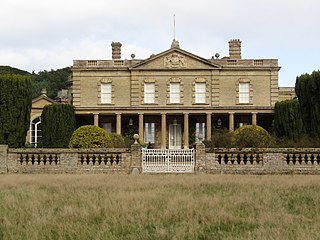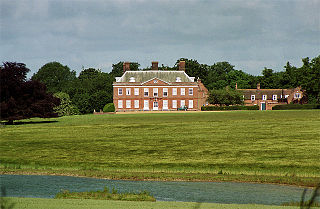Related Research Articles

Wymondham is a market town and civil parish in the South Norfolk district of Norfolk, England, 9.5 miles (15.3 km) south-west of Norwich off the A11 road to London. The River Tiffey runs through. The parish, one of the largest in Norfolk, includes rural areas to the north and south of the town, with the hamlets of Suton, Silfield, Spooner Row and Wattlefield. It had a population of 14,405 in 2011, of which 13,587 lived in the town.

Thorpe Hall at Longthorpe in the city of Peterborough, Cambridgeshire, is a Grade I listed building, built by Peter Mills between 1653 and 1656, for the Lord Chief Justice, Oliver St John. The house is unusual in being one of the very few mansions built during the Commonwealth period. After a period as a hospital, it is currently used as a Sue Ryder Care hospice.

Langley Hall is a red-brick building in the Palladian style, formerly a country house but now a private school, located near Loddon, Norfolk, England. It is a grade I listed building.

Downham Market railway station is on the Fen line in the east of England, serving the town of Downham Market, Norfolk. It is 86 miles 8 chains (138.6 km) measured from London Liverpool Street and is situated between Littleport and Watlington stations. Its three-letter station code is DOW.

Houghton Hall is a country house in the parish of Houghton in Norfolk, England. It is the residence of David Cholmondeley, 7th Marquess of Cholmondeley.

East Barsham Manor is an important work of Tudor architecture, a leading and early example of a prodigy house, originally built in the 1520s. It is located in the village of East Barsham, about 2.5 miles (4.1 km) north of the town of Fakenham and 2.1 miles (3.4 km) south west of the village of Walsingham in the English county of Norfolk. It is protected as a Grade I listed building.

Thetford Priory is a Cluniac monastic house in Thetford, Norfolk, England. It should not be confused with the Dominican Friary of Blackfriars, Thetford that later became part of Thetford Grammar School.
Elkington is a civil parish in the East Lindsey district of Lincolnshire, England. It comprises the village of South Elkington, and the hamlets of North Elkington, Boswell, and Thorpe, and is situated approximately 3 miles (5 km) north-west from the market town of Louth.

Abbas Hall is a small country house in Great Cornard, a village located near the town of Sudbury, Suffolk in England, the Elizabethan exterior of which masks a medieval two-bay aisled hall of c.1290, from which two massive oak posts with moulded capitals and two arches of the screens passage survive. The inserted floor in the great hall was put in about 1548–49. The house was originally the house of West Malling Abbey's manorial steward here. The house, from the grounds of which Thomas Gainsborough painted his celebrated view of Great Cornard Wood, was restored by the present owner, Stefan Kosciuszko, Chief of Staff Hinduja Group, and chief executive AMAS-IPS, the project development company for the Group, after 1995.

Shropham is a civil parish in the English county of Norfolk. It covers an area of 11.12 km2 (4.29 sq mi) and had a population of 351 in 155 households at the 2001 census. For the purposes of local government, it falls within the district of Breckland.

Old Buckenham is a village and civil parish in the English county of Norfolk, approximately 29 km (18 mi) south-west of Norwich.

Colmore Row is a street in Birmingham City Centre in the centre of Birmingham, England, running from Victoria Square to just beyond Snow Hill station. It is traditionally the city's most prestigious business address.

Kilverstone Hall is a Grade II listed building in Kilverstone in Norfolk, England.

Gunton Hall, Gunton Park, is a large country house near Suffield in Norfolk.

Hanworth Hall is a large late 17th century country house some 500m to the south of the village of Hanworth, Norfolk, England. It is protected and recognised in the highest category of the three in the English statutory scheme, as a Grade I listed building.

Hemblington Hall is a large farmhouse in Norfolk county, England, built around 1700 with a Georgian facade. This grade II listed building was the home of the Heath family during the 18th and 19th centuries. The nearby All Saints Church contains memorials to many members of the Heath family. By the 19th century Hemblington Hall was part of the Burlingham Hall Estate owned by the Burroughes family until it was sold off in 1919.

How Hill House is a large, Edwardian house located in How Hill, an area in Ludham, Norfolk. The house is on the River Ant and is part of the Broads National Park. It was designed by the English architect Edward Boardman in 1903, who intended it to be his family's country retreat. The Boardman family owned the house until 1966 before its sale to Norfolk County Council, and then to Norwich Union who eventually gifted the house to the How Hill Trust, an environmental education charity. The house is a Grade II listed building.
Hilton Hall is an early 17th century English country house in the village of Hilton in Cambridgeshire. The hall is listed Grade II* on the National Heritage List for England. The dovecote in the grounds of the hall is listed Grade II.

Ryston Hall, Ryston, Norfolk, England is a 17th century country house built by Sir Roger Pratt for himself. The house was constructed between 1669 and 1672 in the Carolean style. In the late 18th century, John Soane made alterations to the house, and further work on the building was carried out by Anthony Salvin in the mid-19th century. Ryston Hall is a Grade II* listed building.
References
- ↑ Historic England, "Shropham Hall including garden wall to the west (1342425)", National Heritage List for England , retrieved 25 January 2021
- Country Life article 24 February 2005, Pevsner Norfolk 2: North-west and South 1999, Burke's and Savills Guide to Country Houses: Volume III - East Anglia 1981